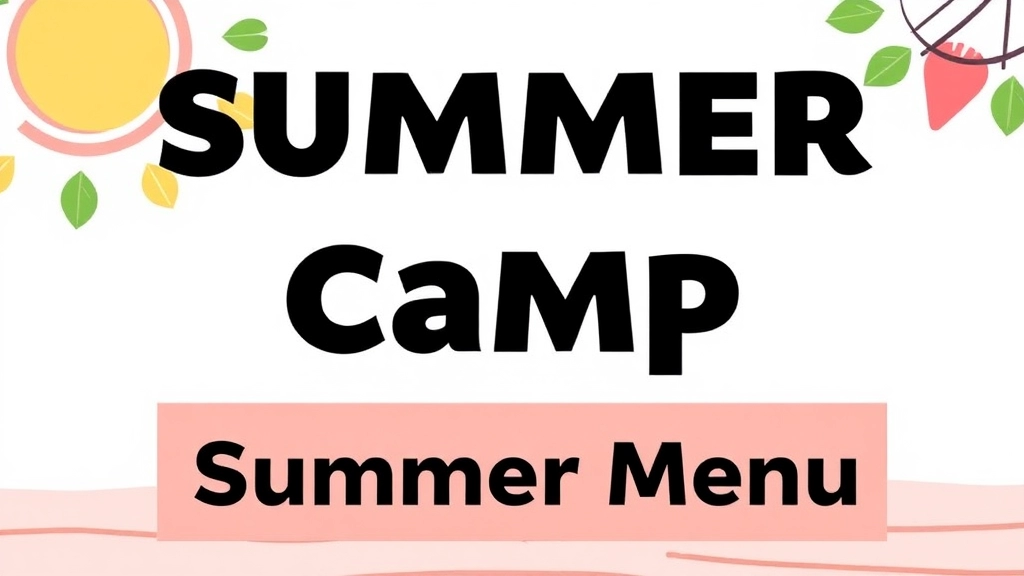Planning a Balanced Summer Camp Menu
Planning a balanced summer camp menu can be quite the juggling act, but it’s essential for keeping campers energized, happy, and healthy. This article will guide you through everything from nutritious breakfast ideas and healthy snacks to dinner recipes for large groups, vegetarian and vegan alternatives, and allergy-friendly meal plans. We’ll also cover hydration strategies, using local and seasonal ingredients, and fun cooking activities to engage the kids.
We’ll start by discussing why a balanced menu matters and break down the key components, such as protein, carbs, and fats. You’ll find practical tips for planning meals, including how to manage food storage and safety. Whether you’re dealing with picky eaters, budget constraints, or time management issues, this guide has got you covered. Let’s dive in and make your summer camp menu a hit!
Planning a Balanced Summer Camp Menu
Alright, let’s get down to it. Planning a balanced summer camp menu can be a real headache, right? You’re juggling picky eaters, dietary restrictions, and the need to keep it nutritious and tasty. But don’t worry, I’ve got your back. Here’s how you can nail it.
Why a Balanced Menu Matters
First off, why is a balanced menu even important? Well, think about it:
- Energy Levels: Kids are running around all day. They need fuel that keeps them going, not something that’ll have them crashing by noon.
- Nutrition: Growing bodies need the right mix of vitamins, minerals, and all that good stuff.
- Variety: No one wants to eat the same thing every day. Plus, variety helps cover all nutritional bases.
Key Components of a Balanced Menu
Now, let’s break down what makes a menu balanced:
- Protein: Essential for growth and repair. Think chicken, fish, beans, and nuts.
- Carbs: The main energy source. Go for whole grains, fruits, and veggies.
- Fats: Don’t shy away from healthy fats like avocados, nuts, and olive oil.
- Fruits and Veggies: Aim for a colourful plate to cover a range of nutrients.
- Hydration: Water, water, and more water. Plus, some fun hydrating options like infused waters or herbal teas.
How to Plan
Here’s a step-by-step approach to planning your camp menu:
- Know Your Audience: Get a list of dietary restrictions, allergies, and preferences.
- Set a Schedule: Plan out each meal and snack time. Consistency helps.
- Balance Each Meal: Ensure each meal has a good mix of protein, carbs, and fats.
- Rotate Menus: Create a 2-3 week rotating menu to keep things fresh.
- Seasonal Ingredients: Use local and seasonal produce. It’s fresher and often cheaper.
Example Menu Plan
To make it even easier, here’s a quick example of what a balanced day could look like:
- Breakfast: Whole grain pancakes with fresh fruit and a side of scrambled eggs.
- Morning Snack: Apple slices with almond butter.
- Lunch: Grilled chicken wraps with mixed greens and a side of quinoa salad.
- Afternoon Snack: Carrot sticks with hummus.
- Dinner: Baked salmon with roasted sweet potatoes and steamed broccoli.
Real Talk: Common Challenges
Let’s be real, planning a balanced menu isn’t always a walk in the park. Here are some common issues and how to tackle them:
- Picky Eaters: Offer build-your-own meal options like taco bars or salad stations.
- Budget Constraints: Plan meals around cheaper, nutrient-dense staples like beans, rice, and seasonal veggies.
- Time Management: Prep ahead. Cook in bulk and freeze where possible.
Internal Links
For more specific meal ideas, check out our sections on Summer Camp Packing List: Essentials You Need and Summer Camp Costs: Budget-Friendly Tips & Insights.
Breakfast Ideas for Campers
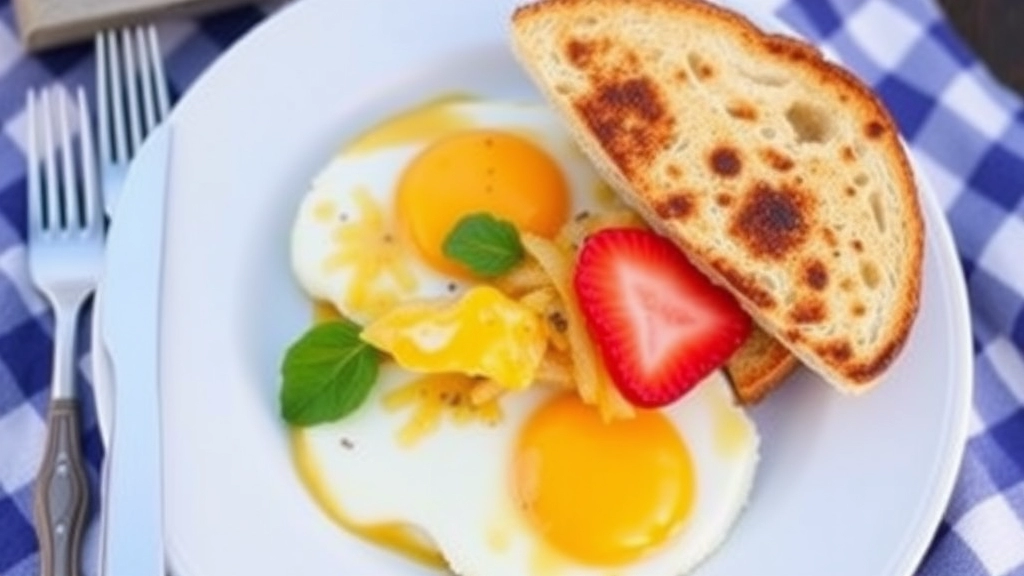
Alright, let’s talk breakfast.
What are you supposed to feed a bunch of hungry campers first thing in the morning?
You’ve got kids with different tastes, allergies, and energy needs. It’s a lot to juggle.
But don’t worry, I’ve got you.
Breakfast is crucial.
It sets the tone for the day, fuels their activities, and keeps them happy until lunch.
Here are some killer breakfast ideas that are easy to make, nutritious, and camper-approved.
Classic Pancakes and Fruit
Everyone loves pancakes.
They’re simple to make and you can whip up a large batch in no time.
Pro Tips:
- Use whole-grain flour for added fibre.
- Serve with fresh fruit like berries, bananas, or apples.
- Offer a drizzle of honey or maple syrup instead of sugar-loaded syrups.
Scrambled Eggs and Veggies
Eggs are a fantastic protein source.
Scramble them up and toss in some veggies.
Here’s what you need:
- Eggs (obviously)
- Spinach, bell peppers, and tomatoes
- A pinch of salt and pepper
Why it’s great:
- Quick to cook
- Packed with protein and vitamins
- Easy to customise for picky eaters
Overnight Oats
Perfect for those mornings when you need something ready to go.
Basic Recipe:
- Rolled oats
- Milk or a dairy-free alternative
- A dash of honey
- Top with fruits, nuts, or seeds
Benefits:
- Make it the night before
- Endless topping options
- Keeps kids full for longer
Smoothie Station
Kids love smoothies.
They’re fun, colourful, and you can sneak in some greens.
Set up a station with:
- Bananas, berries, and spinach
- Greek yoghurt or a dairy-free option
- A splash of juice or milk
Why it’s awesome:
- Quick and easy
- Customisable
- Packs a nutritional punch
Whole-Grain Toast with Toppings
Simple but effective.
Toast up some whole-grain bread and let the kids choose their toppings.
Options:
- Peanut butter and banana slices
- Avocado and a sprinkle of salt
- Cheese and tomato
Perks:
- Minimal prep
- Satisfying and nutritious
- Great for picky eaters
Yogurt Parfaits
Another easy-to-assemble option.
What you need:
- Greek yoghurt
- Granola
- Fresh fruit
Why it works:
- Balance of protein, carbs, and fats
- Easy to customise
- Looks appealing to kids
Breakfast Burritos
A bit more prep, but totally worth it.
Ingredients:
- Whole-wheat tortillas
- Scrambled eggs
- Black beans
- Cheese and salsa
Why they’re a hit:
- Portable
- Packed with protein
- Fun to eat
Nutritious Lunch Options
Ever wondered how to keep campers full and fuelled through the afternoon activities? Crafting a nutritious lunch menu that’s easy to prepare, tasty, and packed with energy can be a bit of a challenge. But don’t worry, I’ve got you covered. Here’s a breakdown of some killer lunch options that will keep everyone happy and healthy.
Balanced and Energising Lunch Ideas
When planning lunch for a summer camp, it’s crucial to balance carbs, proteins, and fats. This ensures the kids have enough energy to participate in all the fun activities. Here are some solid options:
Wraps and Sandwiches
Wraps and sandwiches are a no-brainer. They’re easy to make, versatile, and can be packed with nutrients. Here are a few ideas:
- Chicken and Veggie Wraps: Fill whole-wheat wraps with grilled chicken, lettuce, tomatoes, and a bit of hummus.
- Turkey and Avocado Sandwiches: Use whole-grain bread, lean turkey slices, avocado, and a sprinkle of cheese.
- Veggie Delight Wraps: For the vegetarians, try wraps filled with hummus, cucumbers, bell peppers, and spinach.
Salads That Satisfy
Salads don’t have to be boring. They can be a powerhouse of nutrients if done right:
- Quinoa Salad: Mix quinoa with black beans, corn, cherry tomatoes, and a lime vinaigrette.
- Chicken Caesar Salad: Use grilled chicken, romaine lettuce, a light Caesar dressing, and whole-grain croutons.
- Pasta Salad: Combine whole-grain pasta with veggies like broccoli, cherry tomatoes, and olives, then toss in a light dressing.
Hot Meal Options for a Hearty Lunch
Sometimes, a hot meal hits the spot, especially on cooler days. Here are some hot lunch ideas:
- Veggie Stir-Fry: Stir-fry a mix of colourful veggies and tofu in a light soy sauce, served over brown rice.
- Chicken and Rice Casserole: Baked chicken with brown rice, broccoli, and a sprinkle of cheese.
- Lentil Soup: A hearty, warming option packed with protein and fibre. Serve with whole-grain bread.
Quick and Easy Lunches for Busy Days
When time is tight, these quick and easy options can save the day:
- DIY Pita Pizzas: Whole-wheat pitas topped with tomato sauce, cheese, and a variety of veggies.
- Bento Boxes: Pack a variety of small portions like cheese cubes, whole-grain crackers, fruit, and veggie sticks.
- Taco Bowls: Brown rice, black beans, corn, lettuce, and salsa. Let the kids assemble their own bowls.
Stories from the Camp Kitchen
Let me share a quick story. Last summer, we tried the DIY Pita Pizzas with our campers. Not only were they a hit, but the kids also loved being involved in making their own pizzas. It was an interactive and fun way to encourage them to eat their veggies.
Keeping It Fresh and Engaging
Remember, variety is key. Rotate these options to keep things exciting. Use seasonal ingredients to keep costs down and flavours up. And always keep an eye on food safety â no one wants a case of food poisoning ruining the fun.
For more tips on keeping your camp meals exciting and nutritious, check out our guide on healthy and easy lunch ideas. If you’re looking for ways to manage costs while providing delicious meals, don’t miss our article on summer camp costs.
Healthy Snack Suggestions
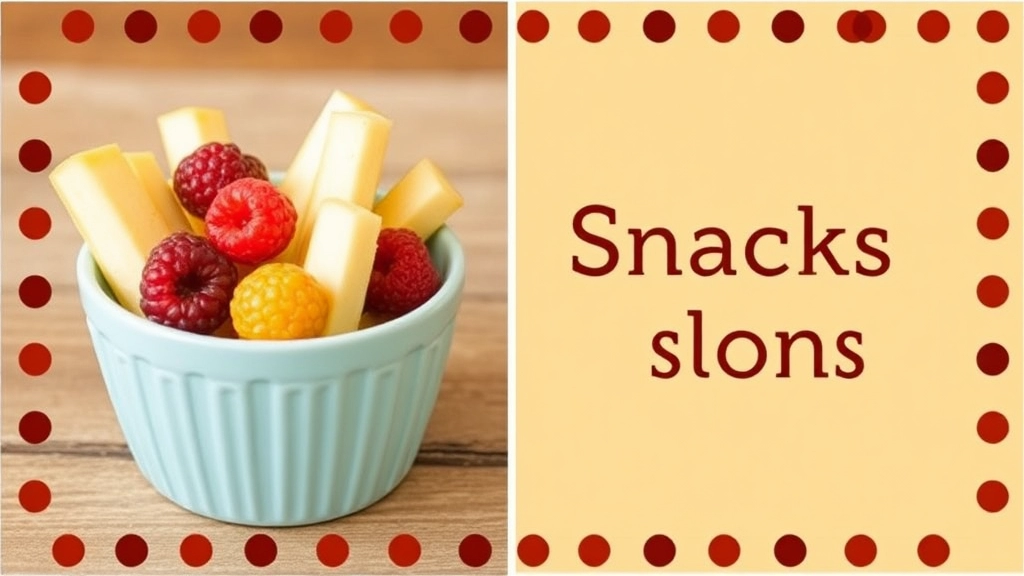
Ever wondered what makes a snack both healthy and satisfying for campers?
I get it.
Kids are picky, and you want to keep them fuelled up without the sugar crashes.
So, let’s dive into some killer healthy snack ideas that are easy to prep and sure to please.
Why Healthy Snacks Matter
First off, let’s talk about why healthy snacks are a game-changer.
- Energy Boost: Kids are active all day. They need snacks that keep their energy levels stable.
- Nutrient-Rich: These snacks can fill in nutritional gaps.
- Mood Stabiliser: Avoiding sugar highs and lows keeps everyone happy.
Quick and Easy Snack Ideas
Here’s a list of snacks that are both nutritious and delicious:
- Fruit Kabobs:
- Skewer chunks of pineapple, strawberries, and grapes.
- Easy to eat and visually appealing.
- Veggie Sticks with Hummus:
- Carrots, cucumbers, and bell peppers.
- Hummus gives a protein boost.
- Trail Mix:
- Mix nuts, seeds, and a few dark chocolate chips.
- Customisable and portable.
- Yoghurt Parfaits:
- Layer yoghurt with granola and fresh berries.
- A treat that feels indulgent but is actually healthy.
- Apple Slices with Peanut Butter:
- Simple yet satisfying.
- Add a sprinkle of cinnamon for extra flavour.
Make It Fun
Kids love interactive snacks. Here are some ideas to keep it engaging:
- DIY Snack Stations:
- Set up a build-your-own trail mix bar.
- Let kids pick their favourite ingredients.
- Fruit and Veggie Art:
- Use fruits and veggies to create fun shapes and faces.
- Makes eating healthy a game.
Allergy-Friendly Options
Got kids with allergies? No problem.
- Nut-Free Trail Mix:
- Swap nuts for seeds like sunflower or pumpkin seeds.
- Dairy-Free Yoghurt:
- Use coconut or almond-based yoghurt for parfaits.
Hydration Matters
Don’t forget to keep the kiddos hydrated.
- Infused Water:
- Add slices of cucumber, lemon, or berries to water.
- Makes plain water more exciting.
- Herbal Teas:
- Serve iced herbal teas.
- Caffeine-free and refreshing.
Real Talk
I remember one summer camp where we introduced fruit kabobs.
Kids loved them.
They even started asking for more fruit during other meals.
It was a win-win.
Healthy snacks don’t have to be boring or complicated.
With a little creativity, you can keep your campers happy and healthy.
So, next time you’re planning snacks, think beyond the usual crisps and sweets.
Trust me, your campers will thank you.
Dinner Recipes for Large Groups
Struggling to Find Dinner Recipes for Large Groups?
Alright, let’s cut to the chase. You’re in charge of feeding a bunch of hungry campers, and you need dinner recipes that are not only delicious but also easy to whip up for a crowd. I get it. The pressure is real. So, let’s dive into some practical, no-nonsense dinner ideas that’ll keep everyone happy and well-fed.
Why Dinner Recipes for Large Groups Matter
When you’re managing a summer camp, dinner is more than just a meal. It’s a time for everyone to come together, share stories, and unwind after a day packed with activities. But feeding a large group can be a logistical nightmare if you’re not prepared. Here’s how to make it work.
One-Pot Wonders
One-Pot Chicken and Rice
This is a lifesaver when you’re short on time and need to feed a lot of people. Here’s why it works:
- Ingredients: Chicken thighs, rice, chicken broth, mixed vegetables, and spices.
- Steps:
- Brown the chicken thighs in a large pot.
- Add rice, chicken broth, and mixed vegetables.
- Simmer until the rice is cooked and the chicken is tender.
- Why It’s a Hit: Minimal cleanup, maximum flavour.
Chilli Con Carne
Another crowd-pleaser that’s hearty and filling.
- Ingredients: Ground beef, kidney beans, tomatoes, onions, garlic, and chilli powder.
- Steps:
- Brown the ground beef with onions and garlic.
- Add beans, tomatoes, and spices.
- Let it simmer for about 30 minutes.
- Why It’s a Hit: It’s spicy, comforting, and perfect for feeding a large group.
Pasta Dishes
Spaghetti Bolognese
An all-time favourite that’s easy to scale up.
- Ingredients: Ground beef, onions, garlic, tomatoes, spaghetti, and Italian herbs.
- Steps:
- Brown the ground beef with onions and garlic.
- Add tomatoes and herbs, then let it simmer.
- Cook the spaghetti and mix it all together.
- Why It’s a Hit: Simple, tasty, and universally loved.
Mac and Cheese
A classic that never fails.
- Ingredients: Pasta, cheese, milk, butter, and flour.
- Steps:
- Cook the pasta.
- Make a cheese sauce by melting butter, adding flour, then milk and cheese.
- Mix the pasta with the sauce.
- Why It’s a Hit: Creamy, cheesy goodness that kids and adults adore.
BBQ Nights
Grilled Burgers
Perfect for a summer evening.
- Ingredients: Ground beef, burger buns, lettuce, tomatoes, cheese, and condiments.
- Steps:
- Form the ground beef into patties.
- Grill the patties until cooked to your liking.
- Assemble the burgers with buns and toppings.
- Why It’s a Hit: Who doesn’t love a good burger?
Veggie Skewers
Great for the vegetarians in the group.
- Ingredients: Bell peppers, onions, mushrooms, zucchini, and olive oil.
- Steps:
- Cut the veggies into chunks.
- Thread them onto skewers and brush with olive oil.
- Grill until tender.
- Why It’s a Hit: Colourful, healthy, and tasty.
Tips for Managing Large Group Dinners
Plan Ahead
- Menu Planning: Decide on your menu well in advance.
- Shopping Lists: Make detailed shopping lists to avoid last-minute runs to the store.
Prep Work
- Chop and Store: Do as much chopping and prep work as possible ahead of time.
- Batch Cooking: Cook in large batches to save time and effort.
Serving
- Buffet Style: Serve meals buffet-style to make it easier for everyone to get what they want.
- Portion Control: Keep an eye on portions to ensure there’s enough for everyone.
Vegetarian and Vegan Alternatives
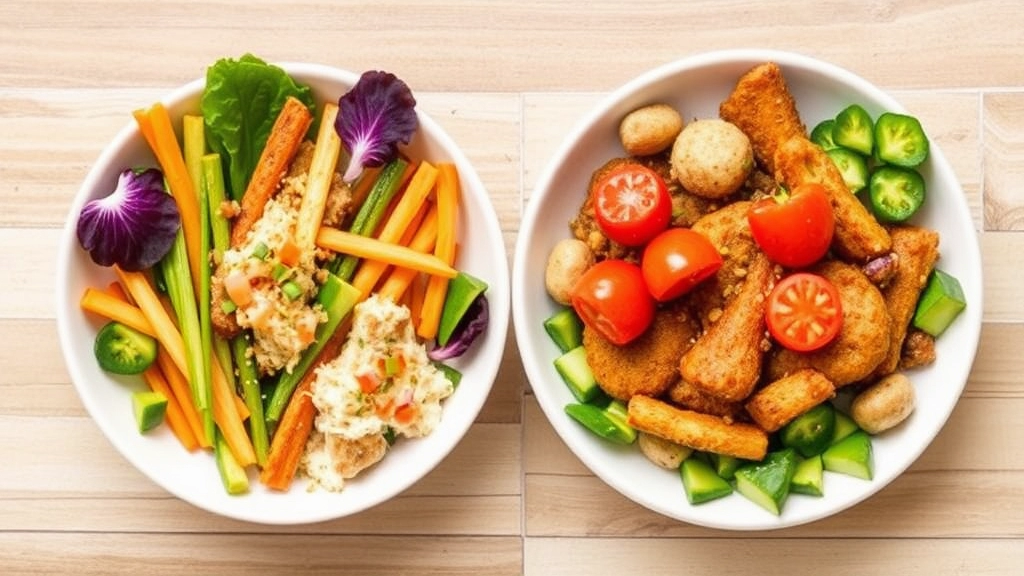
Ever wondered how to keep everyone happy with camp meals? Especially when you’ve got vegetarians and vegans in the mix?
It’s a real concern, right?
Let’s dive into some tasty solutions.
Why Offer Vegetarian and Vegan Options?
Because not everyone eats meat, and you want everyone to enjoy their meals.
Simple as that.
Plus, plant-based meals are often healthier and more sustainable.
Breakfast Ideas
Start the day strong.
Think oatmeal with fresh fruit, or vegan pancakes.
Add some nut butter for protein.
Easy, right?
Lunch Options
Here’s where you can get creative.
- Veggie wraps with hummus
- Quinoa salads packed with beans and veggies
- Chickpea sandwiches on whole grain bread
Quick, filling, and delicious.
Dinner Recipes
Cooking for a crowd?
No problem.
- Veggie stir-fry with tofu
- Lentil stew that everyone will want seconds of
- Plant-based pasta with loads of veggies
These are hearty and satisfying.
Snacks and Desserts
Don’t forget the fun stuff.
- Fruit skewers for a refreshing treat
- Energy balls made with oats and dates
- Vegan cookies for a sweet ending
Keep them simple and tasty.
Handling Allergies and Preferences
Always check for allergies.
Keep a list of ingredients handy.
Make sure there’s no cross-contamination.
Using Local and Seasonal Ingredients
Support local farmers.
Use what’s in season.
It’s fresher, cheaper, and better for the planet.
Interactive Cooking Activities
Get the campers involved.
How about a build-your-own taco night?
Or a DIY salad bar?
It’s fun and educational.
Food Storage and Safety
Keep things fresh.
- Label containers clearly
- Store perishables properly
- Follow food safety guidelines
No one wants a food mishap.
Allergy-Friendly Meal Plans
Alright, let’s dive straight into it. Planning a summer camp menu that’s allergy-friendly can feel like walking a tightrope. What if a camper has a severe nut allergy? What if someone can’t handle gluten? These are real worries, and they can keep you up at night. But don’t sweat it. We’re here to make this as smooth as possible.
Understanding Common Allergies
First things first, you need to know what you’re dealing with. Here are the most common food allergies you’ll likely encounter:
- Peanuts and Tree Nuts: This one’s a biggie. Avoid cross-contamination like the plague.
- Gluten: More and more people are going gluten-free, whether due to celiac disease or sensitivity.
- Dairy: Lactose intolerance or a full-blown dairy allergy can ruin a camper’s day.
- Eggs: They’re in more foods than you might think.
- Soy: Common in many processed foods.
- Fish and Shellfish: Less common but still critical.
Creating an Allergy-Friendly Menu
Let’s break this down into manageable chunks. Here’s how you can create a menu that’s both tasty and safe:
- Label Everything: Clear labels can be lifesavers. Make sure every dish is labelled with potential allergens.
- Separate Cooking Areas: If possible, have designated areas for preparing allergen-free meals. This helps avoid cross-contamination.
- Ingredient Lists: Keep detailed ingredient lists for every meal. This way, you can quickly answer any questions parents or campers might have.
Sample Allergy-Friendly Menu
Here’s a quick example of what an allergy-friendly day at camp might look like:
- Breakfast: Gluten-free oatmeal with fresh fruit and a dairy-free milk option.
- Lunch: Grilled chicken wraps with gluten-free tortillas, served with a side of veggie sticks.
- Snack: Fresh fruit and nut-free granola bars.
- Dinner: Quinoa and veggie stir-fry with a soy-free sauce.
Real-Life Example
Last summer, we had a camper named Jake who had severe nut and dairy allergies. We worked closely with his parents to create a meal plan that kept him safe and satisfied. By the end of camp, Jake’s parents were raving about how stress-free the experience was for them. That’s the kind of impact you want to make.
Handling Emergencies
Even with the best plans in place, accidents can happen. Here’s what you need to do:
- EpiPens: Make sure you have EpiPens on hand and that staff know how to use them.
- Training: All staff should be trained in recognising and responding to allergic reactions.
- Emergency Contacts: Keep a list of emergency contacts and medical information for each camper.
Final Thoughts
Creating allergy-friendly meal plans isn’t just about avoiding certain foods. It’s about creating an inclusive environment where every camper feels safe and cared for. And trust me, when you get it right, parents will thank you, campers will be happy, and you’ll sleep better at night.
For more tips on ensuring a smooth camp experience, check out our essential guidelines for safety and our packing list essentials to make sure you have everything covered.
Hydration and Beverage Choices
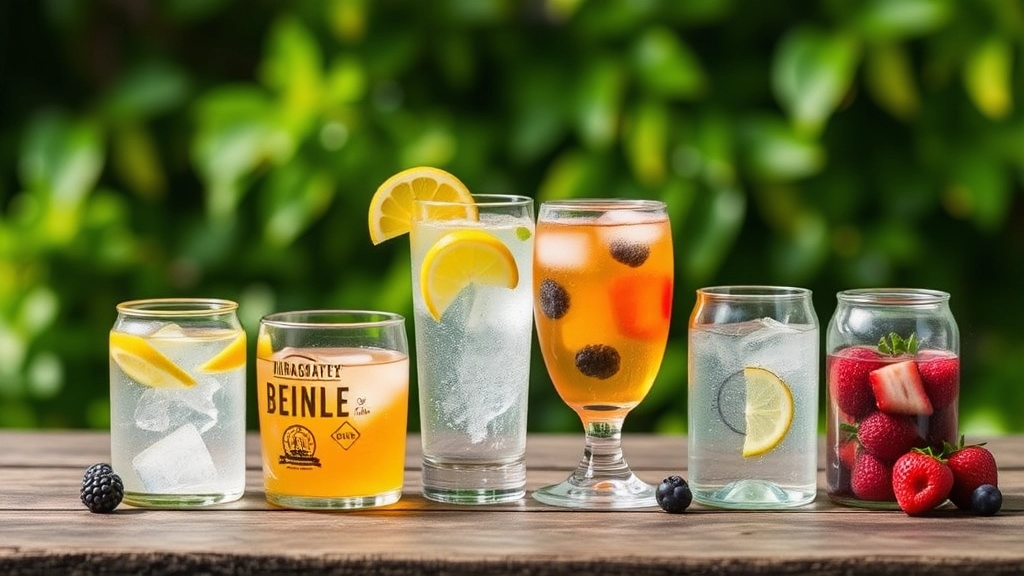
Alright, let’s talk hydration.
Ever find yourself worried about keeping campers hydrated?
It’s a legit concern.
Kids running around, sweating buckets, and the sun blazing down can lead to dehydration fast.
So, let’s dive into the nitty-gritty of hydration and beverage choices at summer camp.
Why Hydration Matters
Staying hydrated isn’t just about quenching thirst.
It’s about keeping energy levels up and preventing heat exhaustion.
Dehydration can sneak up on you, making kids cranky, tired, and even sick.
So, how do we keep everyone hydrated and happy?
Best Hydration Options
First off, water is the MVP here.
Make it accessible everywhere.
Think water stations, water bottles, and even fun water breaks.
But let’s spice it up a bit.
Infused water is a game-changer.
Throw in some cucumber, mint, or berries.
It’s refreshing and adds a bit of flavour.
Electrolyte Drinks
When the heat is on, plain water might not cut it.
Electrolyte drinks can help replenish lost salts and minerals.
But, watch out for sugar-packed options.
Opt for ones with natural ingredients.
Homemade Options
Want to keep it real and fresh?
Try homemade electrolyte solutions.
Mix water, a pinch of salt, a splash of fruit juice, and a bit of honey.
Simple, effective, and healthier than store-bought.
Fun Hydration Ideas
Make hydration fun.
How about a hydration challenge?
Kids love a bit of competition.
Who can drink the most water in a day (within reason, of course)?
Or, set up a hydration station where they can create their own flavoured water combos.
Keeps them engaged and hydrated.
Beverages to Avoid
Steer clear of sugary drinks and sodas.
They might seem like a quick fix, but they’re not doing anyone any favours.
They lead to energy crashes and don’t hydrate effectively.
Hydration Schedule
Create a hydration schedule.
Encourage regular water breaks.
Before activities, during, and after.
Keep it consistent and make it a habit.
Staying Cool
Don’t forget about staying cool.
Ice lollies made from fruit juice are a hit.
They hydrate and cool down at the same time.
Plus, they’re a fun treat.
Incorporating Local and Seasonal Ingredients
Ever wondered how to make summer camp meals not just nutritious but also exciting for the kids? Using local and seasonal ingredients could be your game-changer. Trust me, it’s not just a trendy buzzword. It’s about making food that’s fresher, tastier, and often cheaper. Plus, it’s a great way to teach kids about where their food comes from and how it impacts the environment.
Why Go Local and Seasonal?
First off, local and seasonal ingredients are fresher. They haven’t travelled miles to get to your plate, so they retain more nutrients and flavour. Plus, you’re supporting local farmers and reducing your carbon footprint. Win-win, right?
Here’s why you should consider local and seasonal ingredients:
- Freshness: The shorter the journey from farm to table, the fresher the food.
- Cost-Effective: Seasonal produce is often cheaper because it’s in abundance.
- Nutrient-Rich: Fresher produce retains more vitamins and minerals.
- Support Local Economy: Buying local supports local farmers and businesses.
- Environmental Impact: Less transportation means a smaller carbon footprint.
How to Source Local and Seasonal Ingredients
Okay, so you’re sold on the idea. But how do you actually get your hands on these ingredients?
- Farmers’ Markets: These are gold mines for fresh, local produce.
- Local Farms: Some farms offer direct sales or even pick-your-own options.
- Community Supported Agriculture (CSA): Subscribing to a CSA can get you a weekly box of fresh produce.
- Local Grocery Stores: Many stores now highlight local and seasonal produce.
Seasonal Ingredients by Month
Here’s a quick guide to what’s in season during the summer months:
- June: Strawberries, asparagus, broad beans, radishes
- July: Blueberries, courgettes, cucumbers, tomatoes
- August: Blackberries, peppers, sweetcorn, plums
Sample Menu Using Seasonal Ingredients
Breakfast: Berry Smoothie Bowl
- Fresh strawberries and blueberries
- Local honey
- Granola
Lunch: Veggie Wraps
- Seasonal mixed greens
- Local tomatoes and cucumbers
- Whole grain wraps
Snack: Fresh Fruit Salad
- A mix of seasonal fruits like plums and blackberries
- A squeeze of lemon juice
Dinner: Grilled Veggie Skewers
- Courgettes, peppers, and sweetcorn
- Marinated in olive oil and herbs
Real-Life Example
Last summer, we decided to incorporate more local ingredients into our camp meals. The kids loved visiting the farmers’ market to pick out fruits and veggies. Not only did it make meal prep more fun, but the food tasted incredible. One camper even said, âThis is the best corn I’ve ever had!â
Tips for Incorporating Local and Seasonal Ingredients
- Plan Ahead: Know what’s in season and plan your menu around it.
- Get the Kids Involved: Let them help pick out ingredients or visit a local farm.
- Be Flexible: Sometimes you might not find what you’re looking for. Be ready to swap ingredients.
For more ideas on exciting camp activities, check out our Top 10 Exciting Summer Camp Activities and explore the Nutritious and Fun Summer Camp Food Ideas.
Fun and Interactive Cooking Activities
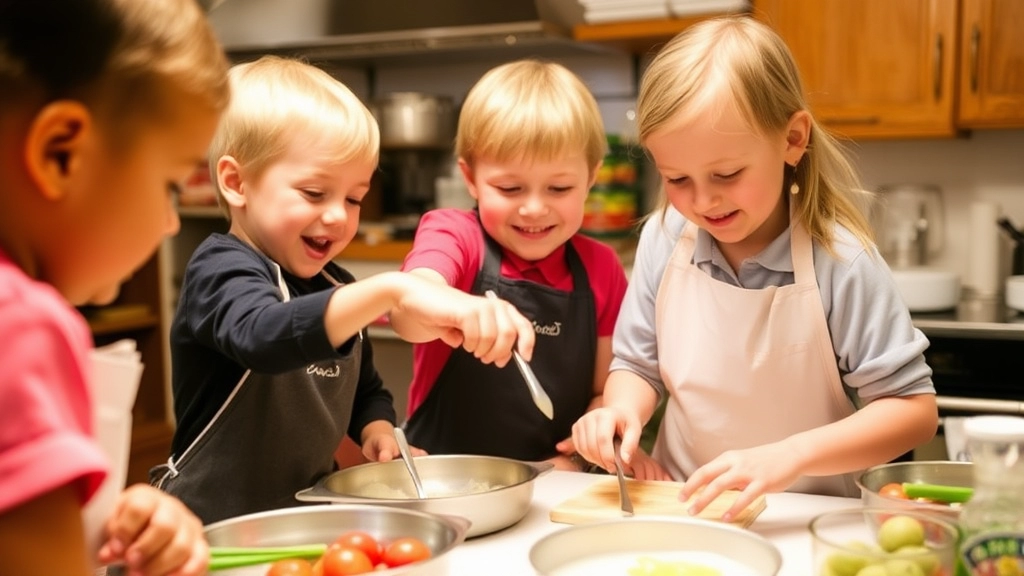
Alright, let’s talk about Fun and Interactive Cooking Activities for your summer camp.
Ever worried about keeping kids entertained and fed at the same time?
I get it. Cooking can be a blast if you do it right.
So, how do you make it fun and educational?
Why Cooking Activities?
First, let’s address the elephant in the room.
Why even bother with cooking activities?
- Engagement: Cooking keeps kids busy and engaged.
- Life Skills: They learn basic cooking skills.
- Teamwork: It promotes teamwork and communication.
- Creativity: Kids get to be creative with food.
Easy and Fun Activities
Now, let’s dive into some activities that are a hit.
1. DIY Pizza Night
Who doesn’t love pizza?
- Ingredients: Pre-made dough, sauce, cheese, and toppings.
- Steps: Let kids roll out the dough, spread the sauce, and add toppings.
- Tip: Have a variety of toppings to cater to different tastes.
2. Fruit Kabobs
Simple, healthy, and fun.
- Ingredients: Various fruits like grapes, strawberries, and pineapple.
- Steps: Provide skewers and let kids assemble their kabobs.
- Tip: Use cookie cutters to make fun shapes out of melon slices.
3. Make Your Own Sandwich
A classic but always a winner.
- Ingredients: Bread, various spreads, veggies, and proteins.
- Steps: Set up a sandwich station and let kids build their own.
- Tip: Offer different types of bread and wraps for variety.
Pro Tips for Success
Worried about the mess or chaos?
Here’s how you keep it smooth.
- Prep Ahead: Pre-cut ingredients to save time and avoid accidents.
- Supervision: Always have adults supervising, especially when using knives or hot surfaces.
- Clean-Up: Make cleaning part of the activity. Kids should help tidy up.
Real Stories
Last summer, we had a group of kids who were initially reluctant to cook.
By the end of the week, they were competing to see who could make the best pizza.
One kid even said, “I never knew cooking could be this fun!”
Tips for Managing Food Storage and Safety
Worried about keeping food fresh and safe at the summer camp?
I’ve got you covered.
Food storage and safety can feel like a headache, but it doesn’t have to be.
Let’s break it down.
Why Food Safety Matters
No one wants a camp full of sick kids.
Foodborne illnesses are no joke.
Keeping food safe ensures everyone stays healthy and happy.
Storage Tips for Keeping Food Fresh
Use Coolers and Ice Packs
Coolers are your best mates.
Fill them with ice packs to keep perishables cold.
Label Everything
Label all food items with the date they were stored.
Helps you keep track of what’s fresh and what’s not.
Separate Raw and Cooked Foods
Avoid cross-contamination.
Store raw meats separately from cooked foods.
Airtight Containers
Use airtight containers for dry goods.
Keeps pests out and food fresh.
Safe Food Handling Practices
Wash Hands and Surfaces
Always wash your hands before handling food.
Clean surfaces regularly.
Cook to the Right Temperature
Use a food thermometer.
Make sure meats are cooked to the right temp.
Chill Leftovers Quickly
Don’t leave leftovers out for more than 2 hours.
Get them in the fridge or cooler ASAP.
Real-Life Example
Last summer, we had a camper with a severe peanut allergy.
We created a peanut-free zone.
Labelled all food items and had separate storage for allergy-friendly foods.
No issues the whole camp.
Pro Tips for Large Groups
Create a Food Safety Plan
Write down all your food safety procedures.
Share it with your team.
Regular Checks
Regularly check your storage areas.
Make sure everything is at the right temperature.
Educate Your Team
Train your staff on food safety.
Make it part of your camp orientation.
For more tips on ensuring a smooth and enjoyable camp experience, check out our guide on nutritious and fun food ideas for summer camps.
FAQs on Summer Camp Menu
What are some nutritious breakfast options for campers?
Breakfast is crucial as it sets the tone for the day and fuels campers’ activities. Some nutritious options include:
- Classic Pancakes and Fruit: Use whole-grain flour and serve with fresh fruit and a drizzle of honey or maple syrup.
- Scrambled Eggs and Veggies: Quick to cook and packed with protein and vitamins.
- Overnight Oats: Make them the night before and top with fruits, nuts, or seeds.
- Smoothie Station: Customizable with bananas, berries, spinach, Greek yoghurt, and a splash of juice or milk.
- Whole-Grain Toast with Toppings: Options like peanut butter and banana slices, avocado, or cheese and tomato.
- Yogurt Parfaits: Layer Greek yoghurt with granola and fresh fruit.
- Breakfast Burritos: Whole-wheat tortillas filled with scrambled eggs, black beans, cheese, and salsa.
What are some healthy snack ideas for campers?
Healthy snacks are essential to keep campers energized and avoid sugar crashes. Some ideas include:
- Fruit Kabobs: Skewer chunks of pineapple, strawberries, and grapes.
- Veggie Sticks with Hummus: Carrots, cucumbers, and bell peppers with a protein boost from hummus.
- Trail Mix: Mix nuts, seeds, and a few dark chocolate chips.
- Yoghurt Parfaits: Layer yoghurt with granola and fresh berries.
- Apple Slices with Peanut Butter: Simple and satisfying, with a sprinkle of cinnamon for extra flavor.
How can I cater to vegetarians and vegans at camp?
Offering vegetarian and vegan options ensures everyone enjoys their meals. Some ideas include:
- Breakfast: Oatmeal with fresh fruit or vegan pancakes with nut butter for protein.
- Lunch: Veggie wraps with hummus, quinoa salads packed with beans and veggies, or chickpea sandwiches on whole grain bread.
- Dinner: Veggie stir-fry with tofu, lentil stew, or plant-based pasta with loads of veggies.
- Snacks and Desserts: Fruit skewers, energy balls made with oats and dates, or vegan cookies.
What are the best hydration options for campers?
Keeping campers hydrated is crucial, especially in the summer heat. Best options include:
- Water: Make it accessible everywhere with water stations and water bottles.
- Infused Water: Add slices of cucumber, mint, or berries for a refreshing twist.
- Electrolyte Drinks: Opt for natural ingredients to replenish lost salts and minerals.
- Homemade Electrolyte Solutions: Mix water, a pinch of salt, a splash of fruit juice, and a bit of honey.
- Fun Hydration Ideas: Hydration challenges or stations where kids can create their own flavoured water combos.
- Ice Lollies: Made from fruit juice, they hydrate and cool down at the same time.
How can I make cooking activities fun and interactive for campers?
Cooking activities can be both fun and educational. Some ideas include:
- DIY Pizza Night: Let kids roll out dough, spread sauce, and add toppings.
- Fruit Kabobs: Provide various fruits and let kids assemble their kabobs.
- Make Your Own Sandwich: Set up a sandwich station with different spreads, veggies, and proteins.
To ensure success:
- Prep Ahead: Pre-cut ingredients to save time and avoid accidents.
- Supervision: Always have adults supervising, especially when using knives or hot surfaces.
- Clean-Up: Make cleaning part of the activity. Kids should help tidy up.
References
-
Breakfast Ideas for Campers
-
Healthy Snack Suggestions
-
Vegetarian and Vegan Alternatives

